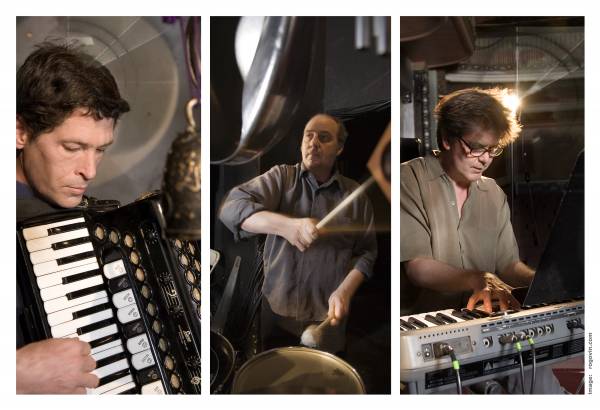
The Alloy Orchestra will play new scores for silent films at the World Financial Center this week (photo by Bruce Rogovin)
NEW SOUNDS LIVE SILENT FILM SERIES
World Financial Center Winter Garden
220 Vesey St.
February 2-4, free, 7:00
212-417-7050
www.wnyc.org
www.artsworldfinancialcenter.com
For nearly a quarter of a century, WNYC host John Schaefer has been presenting New Sounds Live, a series of live music events held in such locations as Merkin Concert Hall and the World Financial Center, featuring an eclectic lineup of musicians that has ranged from Ryuchi Sakamoto, Kitka, and David Hykes and the Harmonic Choir to One Ring Zero with authors Paul Auster, Siri Hustvedt, and Rick Moody. As part of the festival, Schaefer has been curating the New Sounds Live Silent Film Series, in which individuals or groups play live, original scores to silent classics in the WFC Winter Garden. Past years have paired the Club Foot Orchestra with THE PHANTOM OF THE OPERA (Rupert Julian, 1925), the Cinematic Orchestra with MAN WITH A MOVIE CAMERA (Dziga Vertov, 1929), the BQE Ensemble with THE GOLEM (Paul Wegener, 1920), and, last year, Lori Goldston, Wayne Horvitz, and Robin Holcomb with three Yasujio Ozu films. This year Schaefer has enlisted the Alloy Orchestra — keyboardist Roger Miller (Mission of Burma) with multi-instrumentalists Terry Donahue and Ken Winokur — to perform their scores to Buster Keaton’s ONE WEEK (1920), Fatty Arbuckle’s BACK STAGE (1919), and Charlie Chaplin’s EASY STREET (1917) on February 2, Harold Lloyd’s SPEEDY (1928) on February 3, and Douglas Fairbanks’s THE BLACK PIRATE (1926) on February 4. Schaefer discussed the series and more in the latest twi-ny talk.
twi-ny: How did you decide on the specific films that are included in this year’s New Sounds Live Silent Film Series program?
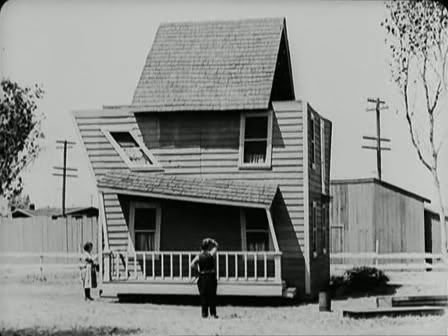
Buster Keaton’s 1920 classic ONE WEEK should bring the house down February 2 at the World Financial Center
John Schaefer: Well, there’s a lot to be said for the Principle of Restricted Choice. In this case, there were several things we wanted to do: One was a series of lighter works, more comic films than the Yasujiro Ozu movies we presented last year. And we also didn’t want to repeat films we’d shown before. Alloy has quite a film repertoire at its disposal, but we’ve worked with them several times over the years so there were a number of films we’d already done. The Harold Lloyd seemed a no-brainer, especially given its New York-centric storyline. And the score that Alloy did for that movie is smart and catchy — an important factor for a series that features live music. The Douglas Fairbanks film, probably best known for the scene where Fairbanks slides down a ship’s mainsail by holding on to a knife that is ripping into the fabric, is not a comedy but it is so over-the-top that you can hardly watch it without grinning — a quality reflected in Alloy’s score, by the way. And the collection of shorts gave us the opportunity to present three of the enduring geniuses of cinema comedy in one fell swoop. That’s what we’ll start the series with, on Wednesday the 2nd.
twi-ny: There are several piano players and groups that specialize in playing live to silent films. What does the Alloy Orchestra bring to these silent films that is different from other accompanists?
JS: The main thing they bring is their Rack of Junk — a ton (and I think I mean that literally) of percussive and other noise-making gear that augments the keyboards, clarinet, accordion, and other instruments that the three musicians also play. Also, this series of films with live music has always focused on music that does not sound like traditional movie-score material. Alloy doesn’t go in for “period pieces”; they create genuinely new music for these old films. As a result, the films seem less like period pieces themselves and more like a still-living art form.
twi-ny: You are the host of WNYC’s “New Sounds” and “Soundcheck,” for which you also write a blog nearly every day, covering a wide range of topics from across the musical spectrum. How has the internet changed the relationship between you and your listeners?
JS: The biggest change since the internet came along is to make communication with the listeners much easier. We get comments every day on “Soundcheck,” many of which we read on the air; “New Sounds” listeners can access web-only content; Facebook and Twitter allow us to keep our audience up to speed on live events (like these films), special guests, etc. And the ability to archive audio is a huge boost; especially with a show that isn’t in prime listening hours. Now, if you don’t want to stay up till midnight, you can still hear “New Sounds” — and hear it anytime you like. And even after all these years, I feel like the digital communication with our listeners is still growing up, unsure of what it’s eventually going to be. For example, we have a sizable treasure trove of videos of live in-studio performances on “Soundcheck,” and at some point we’re gonna figure out how best to organize these things in a way that allows people to easily find and use them. The internet has already made it so much easier to access information about the shows, the music, and more, but there are lots of other ways in which it can and will deepen the audience’s experience, and that’s a real major area of growth for us.
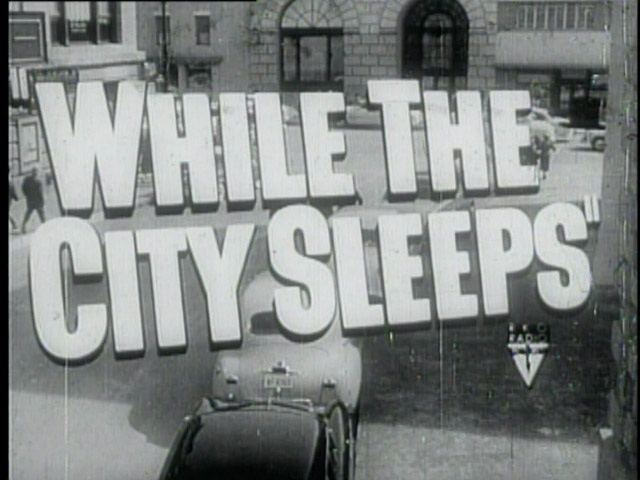
 When media magnate Amos Kynes (Robert Warwick) dies, his son Walter (Vincent Price) takes over despite Amos’s greatest fears. Walter decides that whoever gets a scoop on the Lipstick Killer will become his number two man, so the backstabbing race is on among sleazy wire service chief Mark Loving (George Sanders); managing editor Jon Day Griffith (Thomas Mitchell), who’ll do just about anything for a story; and Harry Kritzer (James Craig), who thinks the best way to get the job is from the bed of Walter’s wife (Rhonda Fleming). Throw in cynical television journalist Ed Mobley (Dana Andrews) and hot-to-trot columnist Mildred Donner (Ida Lupino) and you have another one of Hollywood’s terrific newspaper pics. Director Fritz Lang pulls no punches; the film is filled with plenty of sexual undertones (and overtones), and Kynes himself is a take-off of Charles Foster Kane, the glistening K atop his New York City skyscraper reminiscent of the K atop Xanadu’s front gate. WHILE THE CITY SLEEPS is screening with Lang’s 1948 murder mystery SECRET BEYOND THE DOOR, starring Joan Bennett and Michael Redgrave, as part of Film Forum’s Fritz Lang in Hollywood series, which continues through February 10 with such other great twin bills as MINISTRY OF FEAR (1944) and MAN HUNT (1941) on February 4-5, CLASH BY NIGHT (1952) and RANCHO NOTORIOUS (1952) on February 6-7, and YOU ONLY LIVE ONCE (1937) and YOU AND ME (1938) on February 9-10.
When media magnate Amos Kynes (Robert Warwick) dies, his son Walter (Vincent Price) takes over despite Amos’s greatest fears. Walter decides that whoever gets a scoop on the Lipstick Killer will become his number two man, so the backstabbing race is on among sleazy wire service chief Mark Loving (George Sanders); managing editor Jon Day Griffith (Thomas Mitchell), who’ll do just about anything for a story; and Harry Kritzer (James Craig), who thinks the best way to get the job is from the bed of Walter’s wife (Rhonda Fleming). Throw in cynical television journalist Ed Mobley (Dana Andrews) and hot-to-trot columnist Mildred Donner (Ida Lupino) and you have another one of Hollywood’s terrific newspaper pics. Director Fritz Lang pulls no punches; the film is filled with plenty of sexual undertones (and overtones), and Kynes himself is a take-off of Charles Foster Kane, the glistening K atop his New York City skyscraper reminiscent of the K atop Xanadu’s front gate. WHILE THE CITY SLEEPS is screening with Lang’s 1948 murder mystery SECRET BEYOND THE DOOR, starring Joan Bennett and Michael Redgrave, as part of Film Forum’s Fritz Lang in Hollywood series, which continues through February 10 with such other great twin bills as MINISTRY OF FEAR (1944) and MAN HUNT (1941) on February 4-5, CLASH BY NIGHT (1952) and RANCHO NOTORIOUS (1952) on February 6-7, and YOU ONLY LIVE ONCE (1937) and YOU AND ME (1938) on February 9-10.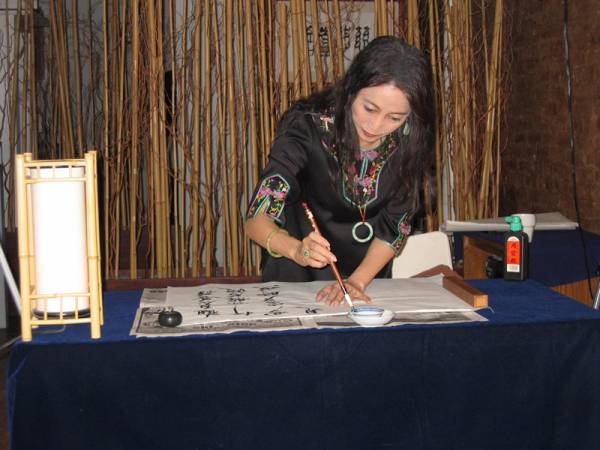
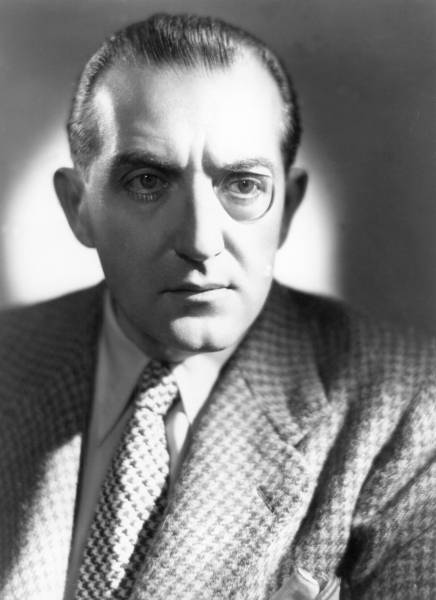
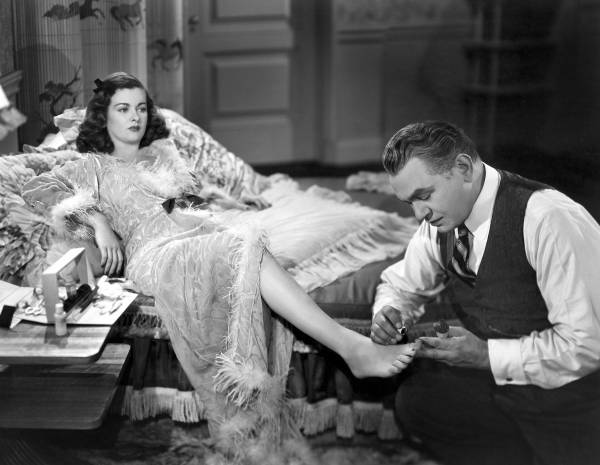
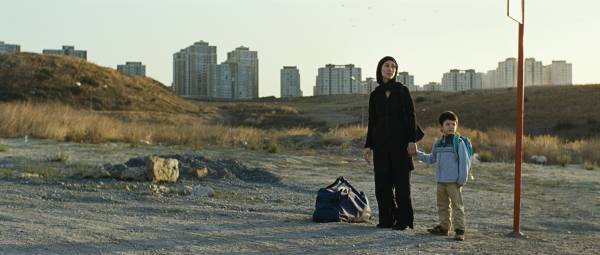
 Viennese actress Feo Aladag makes a powerful directorial debut with her heartbreaking melodrama, WHEN WE LEAVE. Inspired by her work with Amnesty International’s Stop Violence Against Women campaign, Aladag tells the story of a young mother, Umay (HEAD-ON’s Sibel Kekilli), who leaves her abusive husband, Kemal (Ufuk Bayraktar), in Istanbul and returns with her son, Cem (Nizam Schiller), to her family in Germany. But her father, Kader (Settar Tanriogen), her mother, Halime (Derya Alabora), and especially her older brother, Mehmet (Tamer Yigit), insist she return to Kemal despite his mistreatment of her, since she has now brought shame to her family among the tight-knit Turkish community in Berlin. But as Umay refuses their demands and tries to put her life back together, Kader and Mehmet steadfastly turn away from her pleas to be accepted by them and instead conspire to return her and Cem to Kemal, no matter the cost. Winner of the Best Narrative Feature and Best Actress Award (for Kekilli) at the 2010 Tribeca Film Festival and Germany’s official entry for the 2011 Academy Awards for Best Foreign Language Film, WHEN WE LEAVE is a heart-tugging tale of misguided tradition, familial obligation, and the basic need to be loved. The film falters a bit as Umay continues going back to her parents time and time again, risking her life and that of her son, but it’s still a poignant, moving tale reminiscent of Abdullah Oguz’s 2007 film MUTLULUK (BLISS), which brilliantly dealt with the theme of honor killings in Turkey. One of the most frightening aspects of the film is that the crimes of honor it deals with are all too real in numerous societies around the world, although Aladag wisely avoids getting overly preachy and pedantic.
Viennese actress Feo Aladag makes a powerful directorial debut with her heartbreaking melodrama, WHEN WE LEAVE. Inspired by her work with Amnesty International’s Stop Violence Against Women campaign, Aladag tells the story of a young mother, Umay (HEAD-ON’s Sibel Kekilli), who leaves her abusive husband, Kemal (Ufuk Bayraktar), in Istanbul and returns with her son, Cem (Nizam Schiller), to her family in Germany. But her father, Kader (Settar Tanriogen), her mother, Halime (Derya Alabora), and especially her older brother, Mehmet (Tamer Yigit), insist she return to Kemal despite his mistreatment of her, since she has now brought shame to her family among the tight-knit Turkish community in Berlin. But as Umay refuses their demands and tries to put her life back together, Kader and Mehmet steadfastly turn away from her pleas to be accepted by them and instead conspire to return her and Cem to Kemal, no matter the cost. Winner of the Best Narrative Feature and Best Actress Award (for Kekilli) at the 2010 Tribeca Film Festival and Germany’s official entry for the 2011 Academy Awards for Best Foreign Language Film, WHEN WE LEAVE is a heart-tugging tale of misguided tradition, familial obligation, and the basic need to be loved. The film falters a bit as Umay continues going back to her parents time and time again, risking her life and that of her son, but it’s still a poignant, moving tale reminiscent of Abdullah Oguz’s 2007 film MUTLULUK (BLISS), which brilliantly dealt with the theme of honor killings in Turkey. One of the most frightening aspects of the film is that the crimes of honor it deals with are all too real in numerous societies around the world, although Aladag wisely avoids getting overly preachy and pedantic.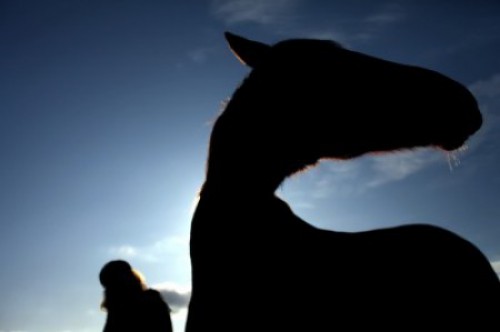
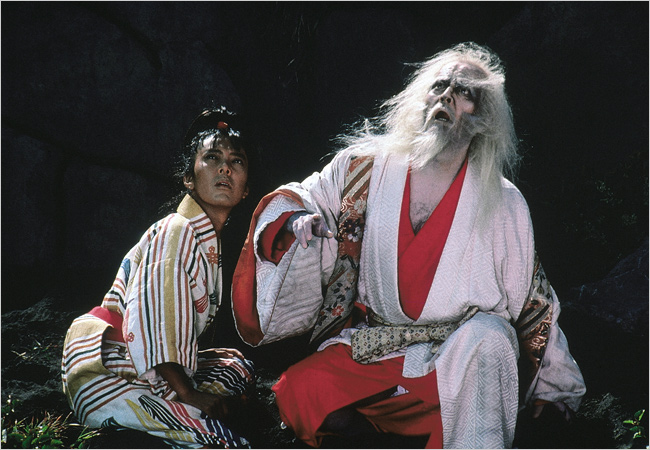
 Inspired by the story of feudal lord Mori Motonari and Shakespeare’s KING LEAR, Akira Kurosawa’s RAN is an epic masterpiece about the decline and fall of the Ichimonji clan. Aging Lord Hidetora (Tatsuya Nakadai) is ready to hand over his land and leadership to his three sons, Taro (Akira Terao), Jiro (Jinpachi Nezu), and Saburo (Daisuke Ryû). But jealousy, misunderstandings, and outright deceit and treachery result in Saburo’s banishment and a violent power struggle between the weak eldest, Taro, and the warrior Jiro. Hidetaro soon finds himself rejected by his children and wandering the vast, empty landscape with his wise, sarcastic fool, Kyoami (Peter), as the once-proud king descends into madness. Dressed in white robes and with wild white hair, Nakadai (THE HUMAN CONDITION), in his early fifties at the time, portrays Hidetaro, one of the great characters of cinema history, with an unforgettable, Noh-like precision. Kurosawa, cinematographers Asakazu Nakai, Takao Saitô, and Masaharu Ueda, and Oscar-winning costume designer Emi Wada bathe the film in lush greens, brash blues, and bold reds and yellows that marvelously offset the white Hidetaro. Kurosawa shoots the first dazzling battle scene in an elongated period of near silence, with only Tôru Takemitsu’s classically based score playing on the soundtrack, turning the film into a thrilling, blood-drenched opera. RAN is a spectacular achievement, the last great major work by one of the twentieth century’s most important and influential filmmakers.
Inspired by the story of feudal lord Mori Motonari and Shakespeare’s KING LEAR, Akira Kurosawa’s RAN is an epic masterpiece about the decline and fall of the Ichimonji clan. Aging Lord Hidetora (Tatsuya Nakadai) is ready to hand over his land and leadership to his three sons, Taro (Akira Terao), Jiro (Jinpachi Nezu), and Saburo (Daisuke Ryû). But jealousy, misunderstandings, and outright deceit and treachery result in Saburo’s banishment and a violent power struggle between the weak eldest, Taro, and the warrior Jiro. Hidetaro soon finds himself rejected by his children and wandering the vast, empty landscape with his wise, sarcastic fool, Kyoami (Peter), as the once-proud king descends into madness. Dressed in white robes and with wild white hair, Nakadai (THE HUMAN CONDITION), in his early fifties at the time, portrays Hidetaro, one of the great characters of cinema history, with an unforgettable, Noh-like precision. Kurosawa, cinematographers Asakazu Nakai, Takao Saitô, and Masaharu Ueda, and Oscar-winning costume designer Emi Wada bathe the film in lush greens, brash blues, and bold reds and yellows that marvelously offset the white Hidetaro. Kurosawa shoots the first dazzling battle scene in an elongated period of near silence, with only Tôru Takemitsu’s classically based score playing on the soundtrack, turning the film into a thrilling, blood-drenched opera. RAN is a spectacular achievement, the last great major work by one of the twentieth century’s most important and influential filmmakers.